
Art and Automatism: Collecting, Politics and Surrealism in Bohumil Hrabal’s Too Loud a Solitude
Alan Ashton-Smith, The London Consortium
1. The Art of Collecting
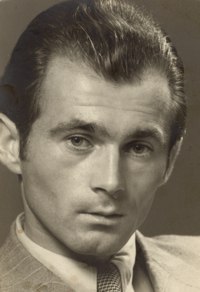 “For thirty-five years I’ve been in wastepaper, and it’s my love story” (Hrabal, Too Loud, 1). So begins Bohumil Hrabal’s 1976 novel Too Loud a Solitude. This is the story of Haňt’a, who is employed in a Prague cellar compacting books and wastepaper into bales. “Books have taught me the joy of destruction” (3), he says, describing how the three and a half decades he has spent in his job have desensitised him to the pulping of the books he loves. Nevertheless, Haňt’a rescues some books and takes them home, where they fill his apartment. However, he hopes to eventually crush these into bales as well:
“For thirty-five years I’ve been in wastepaper, and it’s my love story” (Hrabal, Too Loud, 1). So begins Bohumil Hrabal’s 1976 novel Too Loud a Solitude. This is the story of Haňt’a, who is employed in a Prague cellar compacting books and wastepaper into bales. “Books have taught me the joy of destruction” (3), he says, describing how the three and a half decades he has spent in his job have desensitised him to the pulping of the books he loves. Nevertheless, Haňt’a rescues some books and takes them home, where they fill his apartment. However, he hopes to eventually crush these into bales as well:
I’ve got five years till retirement and my press is going with me, I won’t abandon it, I’m saving up, I’ve got my own bankbook and the press and me, we’ll retire together, because I’m going to buy it from the firm, I’m going to take it home and stash it somewhere among the trees in my uncle’s garden, and then, when the time is right, I’ll make only one bale a day, but what a bale, a bale to end all bales, a statue, an artifact [...] one bale a day from the three tons of books I have waiting at home (8).
He goes on to describe how he will then hold an exhibition of these bales, treating them as works of art. Haňt’a has a great fondness for both the bales he produces and the books that comprise them. When one consignment is collected from the basement in which he works, he wishes he could spend longer with the bales, saying “I was sorry the driver had come so early” (45). And before he compacts the books, he reads many of them, packing himself with knowledge in the same way that he fills his baling machine with books, to the point that he “can’t quite tell which of my thoughts have come from me and which from my books” (1). Zuzana Stoltz-Hladká neatly describes the relationship between thoughts and books that is a key feature of Too Loud a Solitude, providing a broad introduction to the theme of collecting which can be observed in the novel:
A text, as a compilation or collection of words that already exist, is a re-assemblage of waste paper, a repackaging as a book. Undergoing the transformational process that is creative writing, it acquires a new shape as the author's text. In the reading process, it is transformed yet again from the written word into the thoughts that become the basis of future thoughts and future books, by which this endless process of metamorphosis through reshaping and dematerialising is continued ad infinitum ("Bohumil Habral and the Corporeality," 42).
Stoltz-Hladká here links books and words; in Too Loud a Solitude it is also possible to draw a similar connection between books (collections of words and thoughts) and bales (collections of books). Haňt’a can therefore be considered a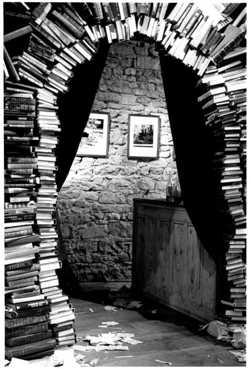 collector in several ways. Firstly, he forms a collection of books to rival that of any bibliomaniac: “my two floor Holešovice apartment is all books: what with the cellar and the shed long since packed and the kitchen, pantry, and even bathroom full, the only space free is a path to the window and stove” (16). In addition, he amasses knowledge in his mind, having garnered this from his continual contact with books. And finally, he aspires to have a collection of compacted books, saying that when he is retired he will keep all of the bales he produces: these bales contain not only books, but also the words and thoughts that comprise the books. So Haňt’a engages in a triptych of collecting that consists of thoughts, books and bales.
collector in several ways. Firstly, he forms a collection of books to rival that of any bibliomaniac: “my two floor Holešovice apartment is all books: what with the cellar and the shed long since packed and the kitchen, pantry, and even bathroom full, the only space free is a path to the window and stove” (16). In addition, he amasses knowledge in his mind, having garnered this from his continual contact with books. And finally, he aspires to have a collection of compacted books, saying that when he is retired he will keep all of the bales he produces: these bales contain not only books, but also the words and thoughts that comprise the books. So Haňt’a engages in a triptych of collecting that consists of thoughts, books and bales.
The narrative arc of Too Loud a Solitude is essentially a very simple one: having been shown a more efficient baling machine, Haňt’a is replaced by a younger, faster team of staff and reassigned to a job compacting only blank paper. This is a devastating change for him, as he considers the contents of his bales crucial to his art. Each bale is wrapped in a reproduction of an Old Master painting taken from a quantity he has had delivered, and deep within each one he buries a specially chosen book, “because I have a need to garnish my bales, give them my stamp, my signature, and I always worry about whether I’ve made a bale distinctive enough” (5). He describes himself as “both artist and audience” (6); he might equally be described as both supplier and collector, creating the bales which are then taken away for pulping, and hoarding the books he hopes to turn into bales. His working process is thus a destructive cycle that renders his collecting of both books and bales futile; while employed in the cellar he cannot create the art he longs for.
Jean Baudrillard’s notion of how collecting functions can be used to explain Haňt’a’s relationship with his machine and his books:
The fact that I make use of a refrigerator in order to freeze things, means that the refrigerator is defined in terms of a practical transaction: it is not an object so much as a freezing mechanism. In this sense, I cannot be said to possess it. Possession cannot be said to apply to an implement, since the object I utilize always directs me back to the world. Rather it applies to that object once it is divested of its function and made relative to a subject (“The System of Collecting,” 7).
Baudrillard goes on to say that an object can have two “mutually exclusive” functions, utilisation or possession, and that once an object no longer has its function, “its destiny is to be collected” (8). In Too Loud a Solitude, this can be observed on two levels. Firstly, Haňt’a’s hope that he can take his machine home with him upon his retirement would cause it to be removed from its function. Although Haňt’a would still be using it to produce compacted bales, these would serve only an artistic purpose, and therefore so would the machine. Secondly, the books that are compacted lose their function as books when they are turned into bales of paper. As such, the bales that Haňt’a hopes to one day hoard can be considered more fitting material for a collection than the books he amasses. His job, which requires the bales to be removed from him, prevents him from gathering the more archetypal of these two potential collections.
2. Politics and Surrealism
This situation is symptomatic of the political situation in Communist Czechoslovakia. After the brief respite of the 1968 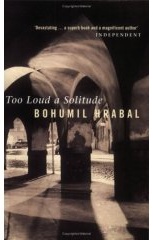 Prague Spring, during which writers had greater freedom of expression, and of which Hrabal says, “the era passed us by and we hardly even noticed how lucky we were” (Total Fears,40), government control was once again tightened. Artistic freedom could not be expressed, and those authors who did not pander to the regime were subject to censorship and bans. Igor Hajek describes how Hrabal fell firmly into this group:
Prague Spring, during which writers had greater freedom of expression, and of which Hrabal says, “the era passed us by and we hardly even noticed how lucky we were” (Total Fears,40), government control was once again tightened. Artistic freedom could not be expressed, and those authors who did not pander to the regime were subject to censorship and bans. Igor Hajek describes how Hrabal fell firmly into this group:
After the Soviet invasion in 1968 and the imposition of a neo-Stalinist regime, Hrabal was considered to be too non-political, too much out of the ordinary, to escape banning. Only when, in 1975, he expressed vague support for the new authorities, could his works be published again; even then, only the innocuous ones, and they showed signs of heavy editing when compared with samizdat versions in circulation (15).
Although Hrabal is often thought of as a political writer and read in the context of contemporaries such as Ivan Klíma and Josef Škvorecký, he began his literary career writing Surrealist poetry, and the influence that the movement had on him remains visible in his later prose. In the “Manifesto of Surrealism,”André Breton says that Surrealism is “Dictated by thought, in the absence of any control exercised by reason, exempt from any aesthetic or moral concern” (“Manifesto,” 26). Surrealism primarily and emphatically involved with the authors' own thoughts; although the surrealists themselves manifested some interest in politics, this means that it is possible to interpret the movement as essentially apolitical. This results in an apparent dichotomy between Hrabal the political writer and Hrabal the Surrealist.
The influence of Surrealism on Hrabal, and in particular on Too Loud a Solitude can be seen most clearly when the novel is compared to one of the major works of the Surrealist movement, André Breton’s Nadja. Firstly, there are stylistic similarities, such as the freeform movement from situation to situation that can be observed in both narratives, and the rambling stream of consciousness that serves to characterise both narrators. Another feature the two texts have in common is the lengthy paragraphs and sentences derivative of the automatic writing that was originated by the Surrealists and practised by Hrabal.
Then there are the comparable incidents that occur in both texts. In Nadja Breton describes “a girl who turned to me without any warning as I was walking along beside her, and asked my permission to recite one of her favorite poems: Rimbaud’s Dormeur du Val. This was quite unexpected, quite improbable” (Nadja,52). In Too Loud a Solitude Haňt’a recalls a man who
last year at the Holešovice slaughterhouse, put a knife to my neck, shoved me into a corner, took out a slip of paper, and read me a poem celebrating the beauties of the countryside at Říčany, then apologised, saying he hadn’t found any other way of getting people to listen to his verse (Too Loud, 95).
The similarity here is in the characters who uncompromisingly insist upon poetry having an audience; the difference is in the degree of force by which they ensure that this comes about. This is fitting though: Breton’s girl appears frivolous, the man who accosts Haňt’a seems violent and unstable, reflecting Too Loud a Solitude’s darker context of Communist Czechoslovakia. Here we see Hrabal using a surrealistic incident in a way that serves the needs of the age contemporary to him.
the degree of force by which they ensure that this comes about. This is fitting though: Breton’s girl appears frivolous, the man who accosts Haňt’a seems violent and unstable, reflecting Too Loud a Solitude’s darker context of Communist Czechoslovakia. Here we see Hrabal using a surrealistic incident in a way that serves the needs of the age contemporary to him.
As such the apparent dichotomy between the surrealist tradition and the political climate of the day can be overcome if Hrabal’s use of surrealism is seen as a political device. Indeed, Hrabal describes his style as “my defence against politics, my policy in fact” (Total Fears, 40). It can be argued that Too Loud a Solitude displays a kind of politicised surrealism, and that the role of collecting in the novel is a crucial element of this. One of the first points made by André Breton in the “Manifesto of Surrealism” regards the freedom of the imagination; “the mere word ‘freedom’ is the only one that still excites me” (“Manifesto,” 4), he says. Roger Cardinal sees this as a key moment in the manifesto, describing the cause of Surrealism as “the defence of the rights of the imagination in an era of depressing intellectual and social conformity” (Breton, 9). Czechoslovakia in the early 1970s can certainly be described as such an era; therefore Surrealism would seem an appropriate vehicle for Hrabal to employ. However, it should be remembered that it was not only imagination that informed Hrabal’s work – in addition there was not only the actualities of Soviet rule, but also the personal memories of an author who on occasion incorporated family members into his writing.
The Surrealist influence on Hrabal had already reached its epitome in his 1964 novel Dancing Lessons for the Advanced in Age, which exaggerated the use of automatic writing by being written in only one sentence. Adam Thirlwell says of this book:
Writing a novel in one sentence let Hrabal show off, and create a hidden taxonomy of form. As the reader continues to read this single sentence, the more he or she begins to notice verticalities, differences, structural links and gaps. The more uniform the apparent technique, the more various and intricate the actual technique becomes (Miss Herbert, 216).
This can also be seen in Too Loud a Solitude, in the way Haňt’a produces his bales: they have a uniform appearance, but the books he has hidden at the centre of each one ensure that their production is not merely a functional activity, but an art. He talks of having learned “to understand the beauty of destruction” (Too Loud, 12), and it is as though he is seeking to create the ultimate example of this in his bales. Indeed, destruction and decay are prevalent throughout the novel, from the mice that chew up Haňt’a’s book collection to the decomposing body of his dead uncle – the transforming process of decay reflects the transformation from books to bales that Haňt’a longs to carry out. There is further uniformity in his aspiration to produce one bale a day; here the intricacy of the actual technique lies in the beauty of each bale. It is when the bales are considered not simply as collections of the books that comprise them, but as collections of the thoughts contained in those books, that they truly become works of art.
3. The Art of Palavering
Referring to Hrabal’s writing, Thirlwell tells us that:
In Czech, there is a word for Hrabal’s style. This word is Hrabalovština. Hrabalovština is a comic display of vocabulary, of headlong words and invented syntax – it is a system which is forever trying to put off its own demise. But Hrabal’s own word for his style was palavering, and palavering is a much more useful and precise concept for this style, this new invention in the art of the novel. Palavering is an art, and it is committed to deferral, to a comic refusal to be polite, and stop talking (Miss Herbert, 208).
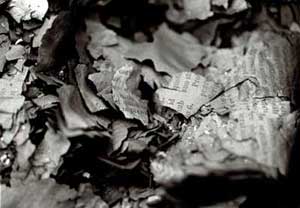 David Short cites Radko Pytlík’s definition of the palaverer, as one who “looks for poetry in everyday reality [...], he defends himself against uglified phraseology and the mannerism of forms of communication. He amuses and grabs our attention with his entirely fresh, unhackneyed way of seeing things” (qtd. in Short, 3). In its search for the poetic in the everyday, palavering can be thought of as a concept that derives directly from Surrealism, and which can be compared with automatic writing in terms of both stylistics and intent. Hrabal’s style can be thought of as one of art and imagination taking precedence over work and authority, and consequently seen as a politically charged device.
David Short cites Radko Pytlík’s definition of the palaverer, as one who “looks for poetry in everyday reality [...], he defends himself against uglified phraseology and the mannerism of forms of communication. He amuses and grabs our attention with his entirely fresh, unhackneyed way of seeing things” (qtd. in Short, 3). In its search for the poetic in the everyday, palavering can be thought of as a concept that derives directly from Surrealism, and which can be compared with automatic writing in terms of both stylistics and intent. Hrabal’s style can be thought of as one of art and imagination taking precedence over work and authority, and consequently seen as a politically charged device.
In addition, it is of note that the art of palavering encompasses that of collecting, with Haňt’a being just one example of a palavering figure who also collects. Indeed, his method of narration is his manner of presenting the thoughts he has collected, which are of course derived from his collections of books and bales. The word Hrabal invented to describe palavering characters is Pábitelé, the title of his second collection of short stories, which included numerous such figures. Further examples include the outspoken Uncle Pepin, who appears in both Cutting it Short and The Little Town Where Time Stood Still; and Leli, the collector if unusable items in The Snowdrop Festival.
Haňt’a is certainly as much a palaverer as any of Hrabal’s other protagonists. His narrative is anecdotal, and frequently highly comic, featuring such recollections as the scatological mishaps a girl he once knew. In addition, the style employed by Hrabal, which loosely resembles stream of consciousness means that Haňt’a’s account seems to channel directly from his thoughts with little or no editing; he is telling his story spontaneously, and perhaps it is as unwarranted as the verse of the poet who holds him up at knifepoint. Indeed, Haňt’a says that he is “both artist and audience” (Too Loud, 6); perhaps he is the only audience that he sees his story having. This can be taken as a comment on the situation of censorship in Czechoslovakia, but it also hones the idea of palavering into a more melancholy art. The added dimension of Haňt’a’s artistic bale-making means that in Too Loud a Solitude palavering seems less frivolous. Palavering is not his main art; it is a secondary to his production of bales. Yet it ends up being brought to the foreground because the impositions of his work mean that he is unable to create his bales in the manner that he desires. The collected thoughts that ought to be preserved in the bales are lost when the bales are pulped, and the thoughts have to remain in Haňt’a’s mind, manifesting themselves in his garbled palavering.
The erratic narrative conveys Haňt’a’s frustration at being unable to produce his art and in this respect the novel is very much a comment on the Czechoslovakian political situation. Pytlík agrees that:
Too Loud a Solitude is motivated by an era in which highly cultured people lived in cellars, in which ‘university educated’ individuals worked as stokers and warehousemen. [...] Haňt’a is ‘educated against his will’ and he comments very thoroughly on the ‘world from underground’, with a philosophical grounding. The world ‘up above’ appears in a mysterious twilight which obscures the contours of characters and gives them the form of phantoms. The world up above is represented by the voice of the fervent boss; in his desire to further his career, he represents the contemporary state of society (The Sad King, 89).
4. A Novel of the Underground
Too Loud a Solitude is therefore a novel of the underground in both literal and literary senses. Down in his cellar, Haňt’a the collector represents the underground artist, the world of banned books and samizdat publishing.* The boss, who hampers his art, chiding him to work more quickly and efficiently, is the authority that prevents artistic freedom. The “Socialist Labor youngsters in their orange gloves” (Too Loud, 78) who take over Haňt’a’s post are the kind of figures that this authority wants the populace to be comprised of. In Nadja, Breton expresses his ardent preference for art over work:
There is no use being alive if one must work. The event from which each of us is entitled to expect the revelation of his own life’s meaning – that event which I may not yet have found, but on whose path I seek myself – is not earned by work (Nadja, 60).
Haňt’a creates art out of his work, but his aim is to create the same art while in retirement, thereby removing his art from the environment of work. Too Loud a Solitude presents art as a means of resistance or even rebellion against work, and Haňt’a’s art is defined by collecting. Haňt’a feels that his working life should be spent in producing art, but his boss has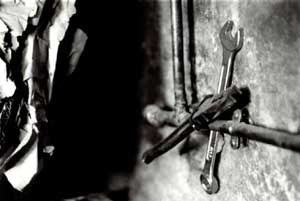 different ideas, and here a dichotomy between art and work emerges.
different ideas, and here a dichotomy between art and work emerges.
The relationship between Surrealism and Communism is worth examining briefly in this context. The Surrealists had a short dalliance with Communism, but had no longstanding interest in its actual intentions. As Matthews says, “After a moment of initial enthusiasm that guided them towards Marxism, it became clear to the Surrealists that they had been attracted to Communism solely as a revolutionary state” (An Introduction, 46). He goes on to say that “So far as the Surrealist is concerned, nothing must be permitted to divert man from his main preoccupation: the search for and revelation of the surreal – a search in which social revolution is but the first, if essential step” (46). As Jacqueline Chénieux-Gendron puts it, ‘Surrealism includes political revolt and revolutionary construction; it is not subject to them’ (Surrealism,148).
Hana Beneš describes Hrabal as a “non-Communist opponent of socialist realism,” going on to say that “Despite his naturalistic and almost cynical tendencies, Hrabal's writings are nothing but an outcry against the crudeness and vulgarity of contemporary life” (‘Czech Literature,’ 100). So Hrabal is using a style of writing influenced by Surrealism in order to convey Haňt’a’s belief that art should take precedence over work, a tenet with which Breton and his peers would be in agreement. Additionally, the fact that Haňt’a creates his art using the machine he is employed to use means that it is he who is stripping it of its function. This constitutes an act of rebellion against work, and consequently against the Communist state. Moreover, in Baudrillard’s terms, Haňt’a has now taken possession of the baling machine, meaning that his rebellion against both his employer and the state seems more proactive than it might otherwise have been. He has reclaimed it, turning it into what Baudrillard would describe as an ‘authentic’ object, an antique which “no longer has any practical application, its role being merely to signify” (The System of Objects, 74).
Baudrillard also makes the point that “Every object claims to be functional, just as every regime claims to be democratic” (63). The baling machine claims to have a function, just as the Communist regime in Czechoslovakia claims to be democratic. In fact, the purpose of the machine is to crush books, so it is destructive rather than functional, and the Communist government also crushes books with bans and censorship. Haňt’a rescues some of these books for a higher purpose; therefore the freedom of the books and his artistic freedom are both represented in his collection. Upon the translation into English of Too Loud a Solitude, Jonathan Coe described Haňt’a’s “being fired and replaced by a more efficient team’ as ‘a simple allegory of Communist authoritarianism” (“Sex and slapstick”), but the function served by the baling machine shows that this allegory is more deeply rooted in the text.
5. The Socialist Machine
However, there is an irony in Haňt’a’s reappropriation of the machine. Although he has caused the baler to take on a rebellious, artistic function, Haňt’a is later presented with “a gigantic press that did the work of twenty” (Too Loud, 62), a more efficient machine manned by more efficient workers. The advent of the new machine and its operators means that Haňt’a is removed from his art, just as writers in Communist Czechoslovakia were frequently removed from theirs. The new workers are directly associated with the new machine, so even though the new machine is not introduced into Haňt’a’s cellar, it is as though his efforts to subvert the work ethic of Communism have ultimately been unsuccessful. The speed of automatism has overtaken the speed of rebellion.
Hrabal’s palavering technique, which has its origins in automatic writing, draws attention to the process of automatism around which Too Loud a Solitude revolves. The interest of the Surrealists in automatism relates to the understanding of the human mind, while the Communists sought to automatise by using ever more efficient machinery; the dichotomy of art 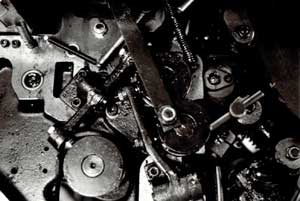 and work reappears here and the incompatibility of the two movements is thus apparent. Matthews says that in Surrealism, “Automatism stands as a method available to all to dredge beneath the surface of the mind and to present for examination a residuum that would otherwise escape notice” (An Introduction, 84). So the automatic form of Haňt’a’s narrative not only reflects the process that is driving him away from his art, but also seems to serve as a way for him to sort through the information that the study of so many books has caused him to amass. His palavering is a method of organisation, as is the prospective destruction of his accumulated books; in this way Hrabal binds his plot and narrative style together in an intricate and tightly-tied knot.
and work reappears here and the incompatibility of the two movements is thus apparent. Matthews says that in Surrealism, “Automatism stands as a method available to all to dredge beneath the surface of the mind and to present for examination a residuum that would otherwise escape notice” (An Introduction, 84). So the automatic form of Haňt’a’s narrative not only reflects the process that is driving him away from his art, but also seems to serve as a way for him to sort through the information that the study of so many books has caused him to amass. His palavering is a method of organisation, as is the prospective destruction of his accumulated books; in this way Hrabal binds his plot and narrative style together in an intricate and tightly-tied knot.
Eventually Haňt’a takes on the same form as the bales he hopes to hoard, immersing himself in ‘the joy of destruction’ (Too Loud, 3) when he climbs into the baler, and switches on the machine. As he does so he reads in one of his books, Novalis’ Blüthenstaub, the line “Every beloved object is the center of a garden of paradise,” and says that “Instead of compacting clean paper in the Melantrich cellar I will follow Seneca, I will follow Socrates, and here, in my press, in my cellar, choose my own fall, which is ascension” (97). In a way, this is the acme of his collecting; having inadvertently immersed himself in the knowledge he has derived from books, he now has to literally immerse himself in the books themselves. Unable to reconcile art with work, he has to become part of his own art. But this act also signifies that Haňt’a is now aware that his collecting, his act of resistance, can continue no longer. The arrival of the new workers means that the paper-crushing job he turned into an art can now be nothing more than work.
The continual influx of books to the cellar demands a team of curators: Haňt’a cannot keep up with the workload alone. But he is apparently the only figure with the will to create art from the books. By adding himself to the collection, Haňt’a is in effect closing it to further acquisitions: with no one to organise it, the collection can no longer expand. Unless it was to expand infinitely, such a collection would have at some stage to be declared complete, and Haňt’a’s act of adding himself, the collector, to the collection renders it so. “I have a physical sense that I too am a compressed bale of books” (7), says Haňt’a at the start of Too Loud a Solitude. At the novel’s close he attempts to use the baler to crush himself into a work of art, along with the Novalis text. Book, man and machine are stripped of their functions simultaneously, and all three become objects of art, destined for collection.
* samizdat (Russian: самиздат) was a key form of dissident activity across the Soviet-bloc; individuals reproduced censored publications by hand and passed the documents from reader to reader, thus building a foundation for the successful resistance of the 1980s. This grassroots practice to evade officially imposed censorship was fraught with danger as harsh punishments were meted out to people caught possessing or copying censored materials. Vladimir Bukovsky defined it as follows: "I myself create it, edit it, censor it, publish it, distribute it, and [may] get imprisoned for it." Etymologically, the word "samizdat" is made out of "sam" (Russian: сам, "self, by oneself") and "izdat" (Russian: издат, shortened издательство, izdatel'stvo, "publishing house"), thus, self published. See: http://en.wikipedia.org/wiki/Samizdat
Works Cited
Baudrillard, Jean. “The System of Collecting,” trans. Roger Cardinal, in: The Cultures of Collecting. Ed. Roger Cardinal and John Elsner. London: Reaktion, 1994. 7-24.
---. The System of Objects. Trans. James Benedict. London: Verso, 1996.
Beneš, Hana. “Czech Literature in the 1968 Crisis” in The Bulletin of the Midwest Modern Language Association. Vol. 5, No. 2 (1992): 97-114.
Breton, André. Nadja. Trans. Richard Howard. New York: Grove Press, 1960.
---. “Manifesto of Surrealism” in Manifestoes of Surrealism. André Breton. Trans. Richard Seaver and Helen R. Lane. Ann Arbor: University of Michigan Press, 1972. 1-47.
Cardinal, Roger. Breton: Nadja. London: Grant and Cutler, 1986.
Chénieux-Gendron, Jacqueline. Surrealism. Trans. Vivian Folkenflik. New York: Columbia University Press, 1990.
Coe, Jonathan. “Sex and slapstick under the hydraulic press” in The Guardian, 21 March 1991.
Hajek, Igor. “Obituary: Bohumil Hrabal: Life Closely Observed” The Guardian, 5 February 1991: 15.
Hrabal, Bohumil. Dancing Lessons for the Advanced in Age. Trans. Michael Henry Heim. London: Harvill, 1998.
---. Too Loud a Solitude. Trans. Michael Henry Heim. London: André Deutsch, 1991.
---. Total Fears. Trans. James Naughton. Prague: Twisted Spoon Press, 1998.
Matthews, J.H. An Introduction to Surrealism. University Park: The Pennsylvania State University Press, 1965.
Pytlík, Radko. The Sad King of Czech Literature. Trans. Katheleen Hayes. Prague: Emporius, 2000.
Short, David, ed. Bohumil Hrabal: Papers from a Symposium. London: School of Slavonic and East European Studies, 2004.
Stolz-Hladk á, Zuzana. "Bohumil Braval and the Corporeality of the World." Bohumil Braval: Papers from a Symposium. 39-53.
Thirlwell, Adam. Miss Herbert. London: Jonathan Cape, 2007.
Note: the photos accompanying this article were taken from the Exhibition inspired by the adaptation of Too Loud A Solitude. In the site devoted to the exhibition we read: “Conceived as an extension of the multidisciplinary album by Ambre, Tran and Berge, it takes the form of a creative experiment which explores the notion of artistic overlapping, mixing texts, drawings and photos. Over a hundred original pages and photographic prints are displayed in a "cemetery" of thousands of books (a symbolic recreation of the pulping machine, a taboo and mythical place, the central element of Hrabal's book), with in counterpoint the contribution of modern media (projections and electronic sound creations).”
More information at: http://www.pastis.org/jade/cgi-bin/reframe.pl?http://www.pastis.org/jade/nov02/solitude/english/toloudasolitude2.htm

